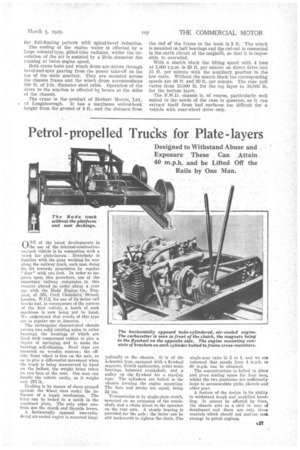Petrol propelled Trucks for Plate-layers
Page 49

If you've noticed an error in this article please click here to report it so we can fix it.
0" of the latest developments in the use of the internal-combustionengined vehicle is in connection with a -truck for plate-layers. Everybody is familiar with the gang working its way along the railway track, each man doing his bit towards propulsion by regular "digs" with one foot. In order to improve, upon this procedure, one of the important railway companies in this eountry Placed anorder about a year ago with the Buda Engine Co., England, of 303, Cecil Chimbeis, Strand, London, W.C2, for one of its motor rail trucks and, in consequence of the success of the first vehicle, a batch of such machines is now being put in hand. We und,erstand that trucks of this type are in regular use in America. • The rectangular channel-steel chassis carries two solid rotating axles in roller hearings, the housings of which are lined with compressed rubber to give a degree of springing and to make the hearings self-aligning. Steel rims are mounted on wooden centres ; the offside front wheel is free on the axle, so as to give a differential movement when the truck is being manoeuvred by hand on the ballast, the weight being taken on two bars at the rear. One man can handle the vehicle easily, as it weighs only 3'75 lb.
Braking is by means of shoes pressed against the wheel rims tinder the influence of a toggle mechanism. The lever can be locked in a notch in the quadrant plate. The only other controls are the clutch and throttle levers.
A horizontally -opposed two-eylindered air-cooled engine is mounted longi tmlinally in the chassis. It is of the L-headed type, equipped With a flywheel magneto, Zenith carburetter' roller main bearings, balanced crankshaft, and a pulley on the flywheel for a starting rope. The cylinders are bolted to the chassis forming the engine mounting.' The bore and stroke are equal, being 2t ins.
Transmission is by single-plate clutch, mounted on an extension of the crankshaft, and a chain direct to the sprocket on the rear axle. A steady bearing is provided for the axle ; the latter can be slid backwards to tighten the chain. The single-gear ratio is 3 to 1, and we are informed that speeds from 4 m.p.h. to 40 m.p.h.' can be obtained.
• The superstructure is bolted in place and gives seating space for four men, whilst the two platforms are sufficiently large to accommodate picks, shovels and other gear.
A feature of the design is its ability to withstand rough and unskilled handling. It cannot be affected by frost, the chassis acts as a skid in case of derailment and there are only three controls which should not confuse men strange to petrol engines.












































































































